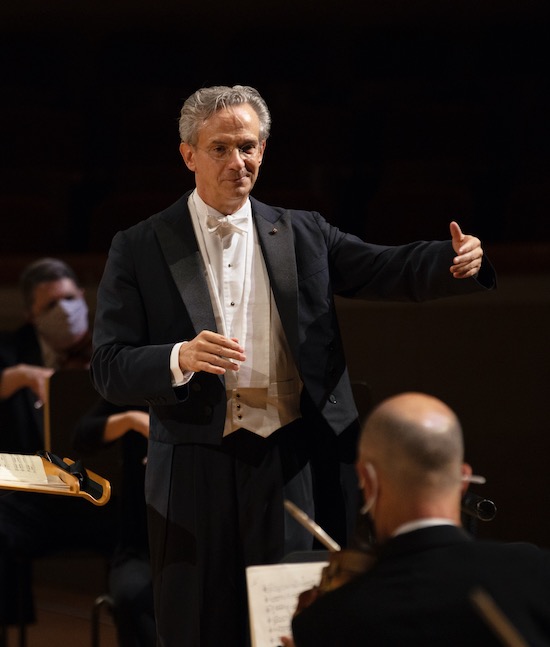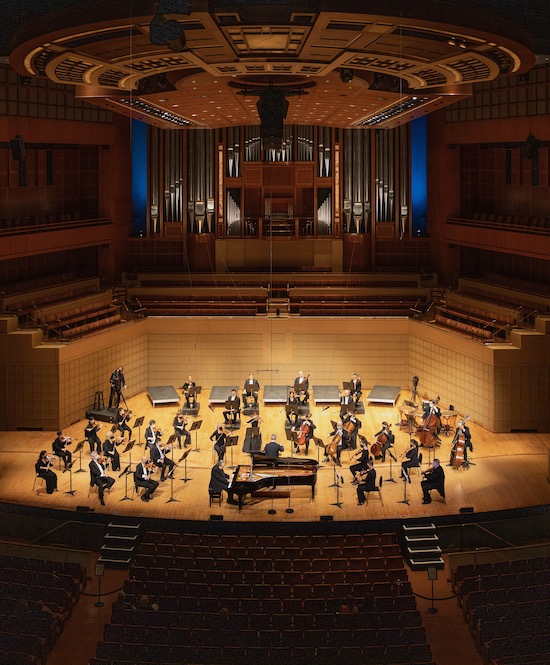Dallas Symphony Orchestra opens a new era with brilliant Beethoven

Amid the continual evolving threat of Covid-19, the Dallas Symphony Orchestra opened its season Thursday night with an all-Beethoven program.
The concert marked Fabio Luisi’s first appearance at the rostrum as the DSO’s music director proper. Considering the imposing level of restrictions in programming and performance practices, Luisi’s debut was a successful first endeavor.
The event also had some broader historical significance. Thursday night’s DSO reopening appears to be the first concert by a major U.S orchestra under its music director since the Covid-19 pandemic and shutdown.
The program ran just over an hour with no intermission, to limit interpersonal interaction. Most crucially, the socially distanced orchestra was spread out on the Meyerson Symphony Center’s extended stage. While Thursday night’s performance opened to a humble audience of 80—mostly hardy season subscribers and a handful of critics, all adequately spaced and masked—one hopes to see a greater turnout as the season gets underway.
This opening weekend’s offering features Beethoven’s Eighth Symphony and Piano Concerto No. 2 with guest soloist Yefim Bronfman. (Brahms Piano Concerto No. 1 was originally slated before the coronavirus forced orchestral down-sizing to the season’s programs.)
Just as well, since Bronfman and the condensed DSO brought an authenticity to the material that was imbued with an early Classical sensibility. With fewer than 40 musicians on stage, the sound was early Beethoven as it’s meant to be heard—strings tempered into brilliant clarity with horns and winds.

Bronfman’s lyrical phrasing was attractive throughout the concerto, with vigorous trade-offs between the piano and ensemble marking the evolving thematic fragments of the first movement. He was equally adept at laying the broadly flowing melody of the pensive second movement, punctuated with a lovely pianissimo at the coda.
The lively rondo of the finale was executed in close coordination between piano and orchestra by Luisi and his soloist. Here, the composer’s characteristic syncopation of the theme was rendered clean and bright by the strings—an effect due, in part, to the open sonorous transparency provided by the necessary reconfiguration.
Often billed as the “little symphony,” for its position between his more behemoth Seventh and Ninth, Beethoven’s Eighth was completed in 1812 after a summer spent searching in vain for a cure for his worsening deafness. Surprisingly, though, it is full of optimism and playfulness.
Luisi’s command and leadership were manifest in this performance. His use of conservative gestures made for an effective use of dynamics while providing an appropriate level of energy. Shifts in tempo at times were less fluid; yet the exchange of the first movement’s principal theme between instruments was managed elegantly, with particularly striking coloring in the winds and brass.
Joviality reigned in the lighthearted scherzando of the second movement—replacing the traditional slow movement—and the third movement saw a beautiful rendering of the horns that open the trio section. The finale, which closed out the evening’s program, was notably fresh and glittering.
All told, the season opener was a triumph for Luisi and the DSO. However necessitated by social distancing, the inventive retooling of the stage yielded a bright, new brilliance for the Meyerson—showcasing the hall’s versatility and mutable sonics. And the expert level of musicianship displayed by the Dallas Symphony members after a six-month hiatus is a glowing testament to the current roster’s caliber.
The program will be repeated 7:30 p.m. Saturday and 2:30 p.m. Sunday. mydso.com, 214-692-0203.


